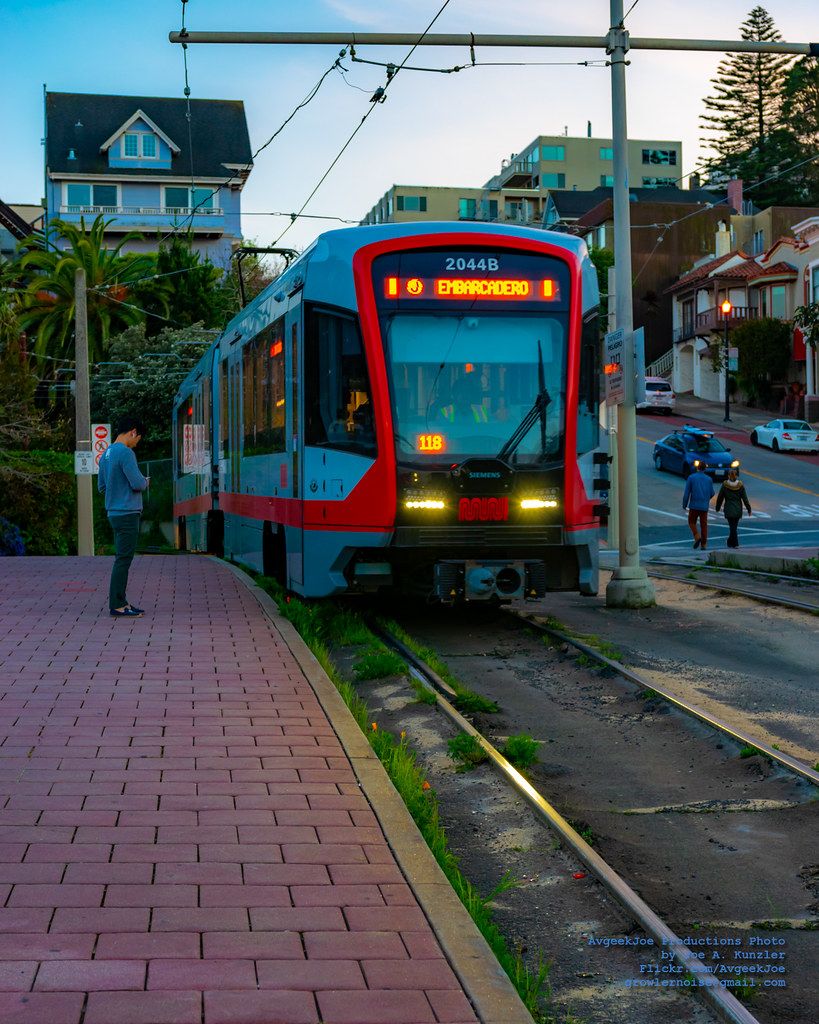MUNI, Are You Okay? What’s Happening With Our Beloved Transit Agency
I was on my way to a sex party when it happened again. I almost felt it rush past, my bewildered eyes darting between street and phone. Arriving, it said, like the ghost of the 38-Geary had erupted from a parallel dimension and onto O’Farrell in true paranormal fashion: visible only to electronics.
It had to be the second time that week. The next one came in 19 minutes. Waiting for Godot’s replacement to cart me to the Bacchanal, I jammed both hands in my pits for warmth and thought: “MUNI, are you okay?”
When I first set out to source material for this piece, the wind was fast and loose (Stuart 86’d the drunken gale via Twitter) and the weather was reasonably cold yet uncharacteristically sunny all across the city. I was headed for my ex’s neighborhood. There’s a turn-around within sight of the water where bus drivers like to stop and smoke, a fact embedded by a decade-old morning routine I followed when I took this bus to BART. Sure enough, three vehicles sat parked on the lot. The first operator I asked for their anonymous opinion about the agency’s plans to address delays and restore full service referred me to MUNI’s website and refused to say more. The next one closed the doors in my face.
“Sure,” said the third operator. “Hop on.”
I wanted to fact-check the announcement made on MUNI’s webpage about schedule updates, but first I had to learn the driver’s landscape, since it directly affects the rider’s experience both on and off the bus. An operator chooses their assignment, taking a different route each day. Seniority gets you the calmer ones while newness earns you demanding routes like the 14-Mission or the 27-Bryant.
“That one goes right by my place. Why is it always so late?”
The 27 is chronically late because its schedule, allegedly unchanged since January, is impossible to honor safely. “[For the 27] to run on time, I’d have to skip stops and run red lights.”
The driver stopped for a young family. Between the beeps of their Clipper cards, I asked if other routes, including those whose schedules were reportedly amended, were also stuck in January.
A silent nod. Which lines exactly weren’t said. We approached a major thoroughfare where the bus quickly filled up.
“So there are drivers out there still operating on five-month-old schedules?”
Some days, “[It’ll be] the same schedule we got in January, same timing, same everything. They didn’t make any changes.”
Whether that includes routes whose schedules reportedly improved in Phases One and Two is unclear. To learn if any pre-Phase One bus schedules have in fact carried over into the present, I reached out to SFMTA for comment.
“I’m not sure what you’re referring to here,” wrote back the representative. “Operators are able to sign up for new routes and schedules. I’m also unclear about the delays you are referring to.”
Back on the bus, we were near capacity. “Can you tell me why I’m seeing so many ghost buses lately?”
I caught their confused reflection in the rearview. “Seeing what?” they asked.
A ghost bus is the spectre of a public transit vehicle sworn to a specified arrival time that never materializes. The evening of the party, I was ghosted by a 38-Geary. For the 51°F night I wore cutoffs and a hoodie zipped up to my neck, the only layer between my titty-hugging t-shirt and a biting onshore wind. It’ll be fine, I told myself earlier, justifying shorts over jeans. You won’t be waiting long. Google says the bus will be here in ten minutes.
“Oh! We call those missing runs,” said the driver. “But a ghost bus… I haven’t heard that one. It makes sense though,” they added with a laugh.
I was pointed to a digital display reflected in the windshield, so glaring I could see it at mid-day. “See that number? That’s my run ID.” A run (the length of trip from end to end) is numbered and tagged via GPS by SFMTA. Google, NextBus, Evo, Apple’s map service: they all rely on data possessed and transmitted by dispatch. “Dispatch can delete a run if that driver ends their shift or their coach gets put out of service, but it doesn’t always happen.” If a number isn’t taken out of rotation, its run will haunt the rest of the route.
There I had it. The ghost bus phenomenon comes down to the same reason found at the core of many blunders: someone forgot something. It does not explain whether the schedules of in-service routes are current or even realistic. Of the eight MUNI employees I spoke with, three responded cordially, two confirmed the copy + pasting of obsolete schedules, and only one was willing to go into details.
Behind this time management crisis lurks a plainer, bleaker one. Right now there simply are not enough drivers to restore service to its pre-pandemic coverage. “COVID wiped us out,” I was told, and while insurance benefits and workplace camaraderie are high, operators cannot afford to live in the city they work for at their current pay rates. Many have left California altogether.
I thanked my driver for their time and asked if MUNI treats them with respect.
“They do. They’re a good company to work for. I don’t blame them,” said the friendly driver towards the end of my ride. Every employee I spoke with for more than a few surly seconds expressed some form of gratitude. “They’re doing what they can with what they have, but we’ve got folks coming in from Pittsburg, Tracy, even Sacramento to work their shifts. It’s not sustainable.”
Conveniently at a board meeting on Tuesday, May 3rd, SFMTA Director Jeff Tumlin was asked about the means of increasing driver pay. His reply:
“One of the upsides to having a thousand vacancies in your organization: many of those vacancies are supervisors and managers. What this has created is tremendous upward career path opportunities for our existing staff.”
I combed the transcript for mentions of a pay raise and turned up none, lending the impression of an unadjusted salary for the drivers taking over routes once operated by their new bosses as opposed to increased wages for drivers already familiar with a city they’re so fond of, they made a career keeping its blood running.
“As a public agency,” continued Director Tumlin, “we don’t promote people necessarily. We do allow them to compete for higher-ranked jobs. People who have a deep understanding of San Francisco and the SFMTA and how we work, compete exceedingly well for those.”
I know at the end of the day that MUNI is a company. Revenue and profit aren’t synonyms, although it’s fairly straightforward to me, a person who hasn’t driven any kind of vehicle in six years, that inadequate pay + global pandemic = less drivers; less drivers = fewer buses. Factor in the everyday chaos of traffic accidents and emergencies and you get irregular bus service and inaccurate arrival times. What about finding new drivers? Didn’t MUNI just host a hiring event?
Vetting and hiring drivers is a lengthy process. To drive for SFMTA, you need to graduate from their nine-week comprehensive training program, then take another two weeks to figure out the city’s electrically powered trolley fleet, followed by three more months for light rail vehicles. I would hope a viable salary lies at the end of all that work—yes, enough to afford rent in San Francisco. That should not be an indulgence. If you love it here, if you want to be here, you should be able to live here.
Let’s be clear: we love MUNI here at BAS. It’s what literally brings us together. I am not here to criticize or shame our only citywide public transportation. What I’d like is for the gap between SFMTA’s projections and the actual conditions faced by drivers to shrink—hell, close entirely if we’re being greedy—and while we’re at it, better pay for the extra-essential workers hauling other essential workers to their jobs.
Board of Directors, please pay your fair share.
We were snaking through jasmine-walled corridors between pastel and whitewashed homes, my favorite part of the trip, until the train emerged at the top of Dolores Park. The crystalline spires of downtown San Francisco glistened in the tangerine light of a sun that seemed nestled in the distant Berkeley Hills, the waters of the Bay between us bright as molten steel.
I left the afterparty shortly after dawn and discovered I was only blocks away from the J-Church. Phase One of SFMTA’s improvement plans saw the return of the J train to the subway. I could take it all the way to Powell Street once again, a short walk from home. Thank you precious MUNI operators, for delivering me safely from the orgy.
It doesn’t matter why you take MUNI. It matters that you get there.











